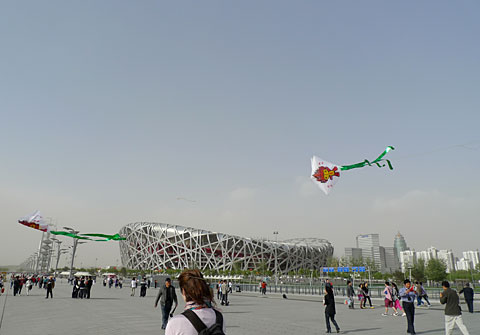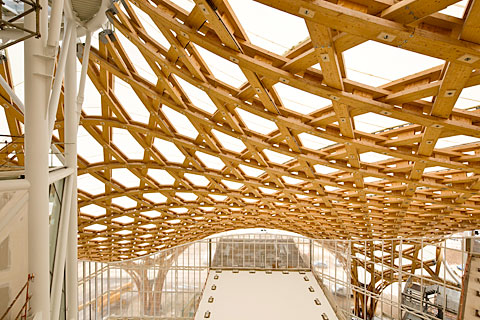Summer is prime time for wickerwork: There are sun hats, fans and picnic baskets and, above all, beach and rocking chairs, all in wickerwork that invites us to sink in lazily. The technique of making things by weaving, however, is also used for more profane products such as fly swats, trivets, odor-absorbing laundry baskets, vacuum flasks with a wicker casing for a safer grip or something that is almost extinct, like rug beaters.
Many products traditionally manufactured from wicker have been squeezed out of the market by industrial products and can now only be found in museums as folk art in the form of baskets or carrier bags and mats or cords made of flexible material, particularly raffia, willow, brushwood, rattan or rush.
However, industry discovered wickerwork as a means of decoration. When, for example, Renault launched its special edition R4 "La Parisienne" with its sweet feminine lines in the early 1960s, the carmaker set out to address modern women who at the time were not really into the anonymous sheet metal yet. The sides of the compact car were printed with a wickerwork pattern and are now as good as cult. It was as if a nostalgic quotation in the form of traditional honeycomb wicker could offset the aesthetics of the handicraft that had since disappeared.
Today, the return to established products and traditional crafts is back en vogue. It was its wicker furniture with which Dedon made a name for itself. The company, which is actually known for having replaced classic wickerwork materials such as bamboo, reed, rattan, seaweed, rush or willow branches by a durable and low-maintenance synthetic material, namely Hularo fiber, is now marketing its innovative high-tech wicker furniture in its advertisements which feature products made of natural materials: We find charmingly woven birdcages and bicycles which are charmingly enveloped in raffia. The present trend of wickerwork might have been the driving force behind Dedon's romantic nostalgic self-representation, which points at the debate on ecology and sustainability.
Every generation seems to develop its own liking for wickerwork at some point. The last great drive in which everything from beds to the wall papers needed to be woven came and went with the Hippie movement of the 1960s and 1970s. However, the range of products in the rattan stores that populated the high-streets at the time always had a touch of the kitsch of trophies that had just been brought home from the last holiday in Indonesia. So why is there such a tide of wickerwork sweeping through fashion, design, architecture and our everyday lives at the moment? At least, the fact that people are fiddling about in a homey manner and in harmony with nature and traditional crafts fits in with this rather inconvenient time of the financial crisis, a new-found enthusiasm for handicraft and high expectations of environmental protection which have returned to the fore.
Children in kindergartens now build caves with their own-cut willow twigs again. Parents proudly carry hand-made baskets by Manufaktum to the market, and colorful beach bags that were produced in Mexico in a politically correct manner, namely woven with recycled plastic, are the ideal accessories for a visit to the beach. The new "Straw Vote" purse by Chanel looks like an old sewing box. Conran Shop replicates traditional French wicker furniture like the one we can find on flee markets in France and promises its customers materials that have a "soul". Patricia Urquiola does not let a season pass without reinterpreting traditional weaving techniques time and again as, for example, in the case of her "Canasta" lounger which features rush wickerwork with a honeycomb pattern that is enlarged to the size of portholes. There is also wickerwork on a larger scale: Two years after the inauguration of the "Bird's Nest" stadium by Herzog & de Meuron on the occasion of the Olympic Games in Beijing, the Centre Pompidou in Metz opened featuring a woven roof by the ingenious bamboo artist Shigeru Ban, which looks like a traditional Chinese hat used for field work.
What was the development of weaving in the last century and what significant pieces of wickerwork have influenced the history of design? Being one of the oldest cultural achievements of humanity, over time wickerwork has interwoven many different influences. There is hardly any region in the world which has not developed its own weaving techniques with the natural materials available to it. Every era - be it the baroque, Biedermeier or Wilhelminian style - produced manifold formal languages which always also reveal a mixture of a region's own tradition and influences of foreign cultures, be it the Louis Seize chairs for the Orangerie that have a slight tropical touch, the products of the Austrian avant-garde blacksmith's shop "Prag Rudnik" or the fabulous hermaphrodite from 1950, the "Margherita" chair by Franco Albini, a mixture of European modernism and the exotic nature of distant countries.
In the middle of the 19th century, Thonet's bentwood chair caused a real sensation. Its woven seat which featured Viennese wickerwork, also called the octagon or honeycomb pattern, is characteristic of the chair. For the first time it was possible to produce the rush wickerwork, which adapts to our ergonomics over the years, industrially. However, the enthusiasm of the modernist resulted from the quasi natural principle of "form follows function" which is characteristic of all weaving techniques. A simple straw-weave upholstery is one of the most popular classics of a nameless everyday design. This functional, almost perfect prototype design which was as common in traditional farmhouses as it was in churches and royal houses and that today is often referred to as "Gasthausstuhl" (restaurant chair) was honored by a flood of interpretations: for example, by Charlotte Perriand, Vico Magistretti or Gio Ponti who had Indian wickerwork used for his "Supperleggera" chair.
During Scandinavian Modernism, ranging from Alvar Aalto to Hans Wegner, when people had a real weakness for wicker chairs, other materials were added in the 1920s: for example, broad linen bands or Danish Paper Card, twirled paper which reminds us of the success of the American "Loom Chair" that with the invention of packaging paper became a colonial style trend which was sold in vast numbers at the beginning of the previous century. The first completely woven piece of furniture which did entirely without a wooden frame construction was launched by Egon Eiermann in the era of German post-war design: the legendary "E10" whose voluminous, cushion-like wickerwork looks like the funnel-shape of a organic blossom.
Those who wish to get comfortable in their gardens on contemporary design furniture can rest on the smoothly curved wicker lounger by the Dutch designer Roderick Vos or enjoy a break in the shade on the "Patio" chair by Studio Hannes Wettstein, a chair covered with large-pored rush wickerwork. In keeping with this the Financial Times served up the saccharine superstructure in its high-gloss supplement. According to it, wickerwork displays an aesthetics which together with a feel of authenticity, semi-transparency and the numerous design possibilities the former offers, perfectly fits in with today's trends in interior design. However, this can be put much more simply: Weaving is the world's simplest construction method.
 R4 special edition „La Parisienne" by Renault
R4 special edition „La Parisienne" by Renault
 Café Berlin in Quedlinburg, photo: Erich Westendarp, pixelio.de
Café Berlin in Quedlinburg, photo: Erich Westendarp, pixelio.de
 Hand-bag "Straw Vote" by Chanel
Hand-bag "Straw Vote" by Chanel
 Stade "Bird`s Nest" by Herzog & De Meuron in Beijing, photo: Berit Nagel
Stade "Bird`s Nest" by Herzog & De Meuron in Beijing, photo: Berit Nagel
 Centre Pompidou-Metz © Shigeru Ban Architects Europe and Jean de Gastines Architectes Photo: Roland Halbe
Centre Pompidou-Metz © Shigeru Ban Architects Europe and Jean de Gastines Architectes Photo: Roland Halbe
 Centre Pompidou-Metz © Shigeru Ban Architects Europe and Jean de Gastines Architectes Photo: Roland Halbe
Centre Pompidou-Metz © Shigeru Ban Architects Europe and Jean de Gastines Architectes Photo: Roland Halbe
 Superleggera by Gio Ponti for Cassina
Superleggera by Gio Ponti for Cassina
 Agung by Roderick Vos for Driade
Agung by Roderick Vos for Driade
 Beach-trophies, photo: Rike, pixelio.de
Beach-trophies, photo: Rike, pixelio.de
 Ad campaign for Dedon by Bruce Weber
Ad campaign for Dedon by Bruce Weber
 Ad campaign for Dedon by Bruce Weber
Ad campaign for Dedon by Bruce Weber
 Shopping-baskets at a market, photo: Vera Winandy Rang, pixelio.de
Shopping-baskets at a market, photo: Vera Winandy Rang, pixelio.de
 Stade "Bird`s Nest" by Herzog & De Meuron in Beijing, photo: Berit Nagel
Stade "Bird`s Nest" by Herzog & De Meuron in Beijing, photo: Berit Nagel
 Centre Pompidou-Metz © Shigeru Ban Architects Europe and Jean de Gastines Architectes Photo: Roland Halbe
Centre Pompidou-Metz © Shigeru Ban Architects Europe and Jean de Gastines Architectes Photo: Roland Halbe
 Production of the chair 214 at Thonet, photo: Nina Reetzke
Production of the chair 214 at Thonet, photo: Nina Reetzke
 214 by Thonet
214 by Thonet




